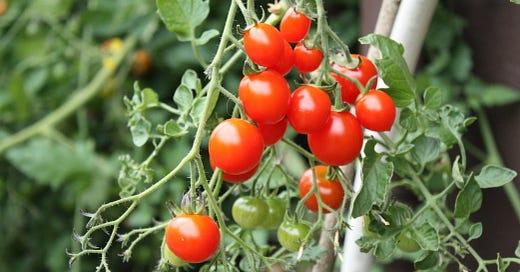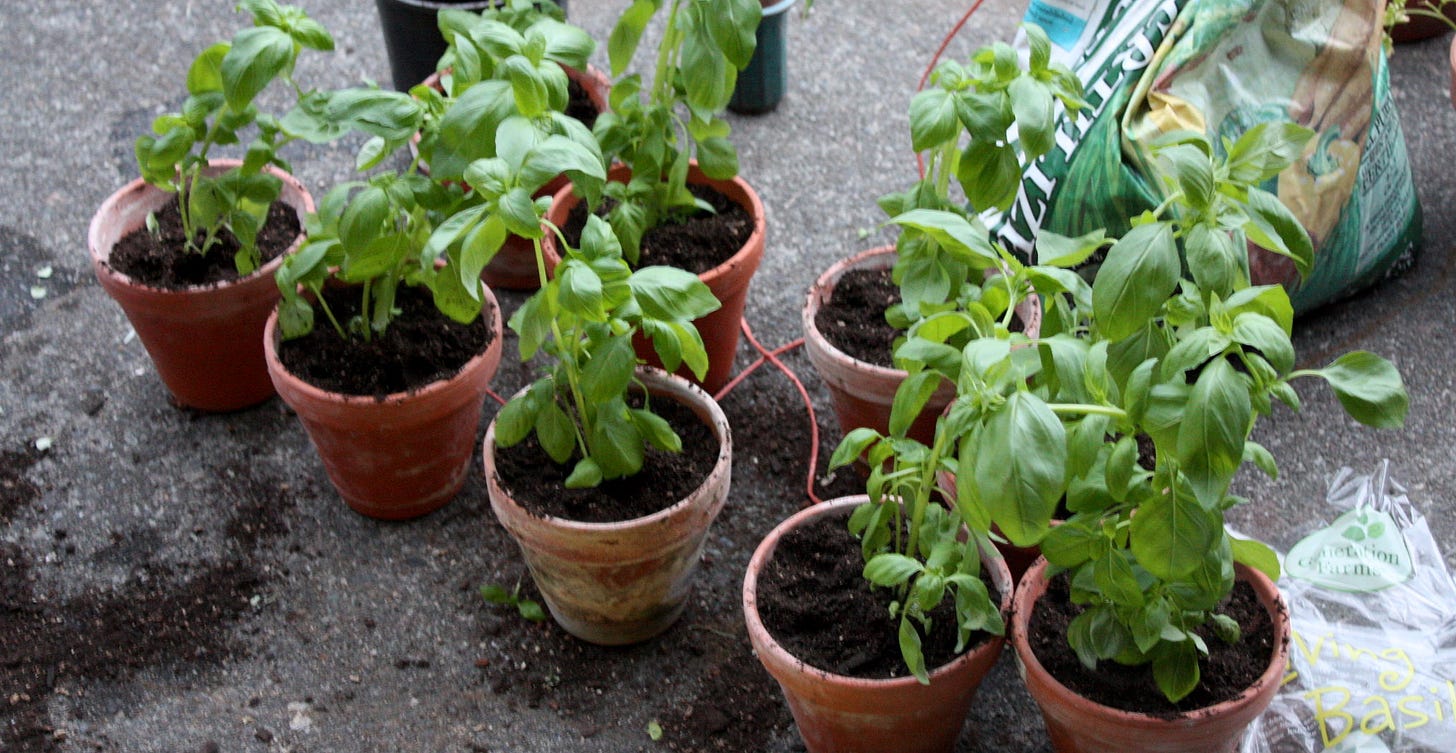Two weeks ago I accidentally started a garden club. Let me explain.
Lately I have been thinking about physical items as energy. I have all these things in my house—children’s books from my nieces and nephew (no longer small children), clothes and jewelry I don’t wear any more. They should be in use—energy in motion—not just stagnant and cluttering up my life.
So, when someone in my Buy Nothing group asked if anyone had spare pots for starting seeds, I immediately said yes. I have lots. Maybe I will use them in the future, but if someone else has need of them now, they should be used. Energy in motion, not stagnating.
As I sorted the cobwebby pots, I began to think. With the economy and political instability of this moment, I suspect people who have never gardened before are looking at their yards and wondering what they might grow.
I walked back into the house and wrote this on the Buy Nothing group:
I've had an idea and wanted to see if there is any interest in it.
With the state of the world/economy right now, I have a feeling more people may be wanting to grow an edible garden this year.
If you're new to gardening, want to learn more, need supplies, or just want company, would you be interested in doing it together?
I am trained as a master gardener, a Permaculture designer, and I've written four books on gardening. I also have a lot of materials that are going unused (pots, seeds, etc.).
If I set up a semi-regular, semi-educational gardening session (maybe once or twice a month), would anyone want to join in?I thought I might get 4-6 people; we could all sit around a table, start seeds together, and chat. It would be nice.
Within 24 hours, more than 40 people had said yes. Now we’re up to 50.
We’re figuring out how best to proceed, because that many people do not fit around a table.
We have our own Facebook group, I’m considering doing some video content, I have a few volunteers from the group helping me, and some accomplished local gardeners have offered to lead tours of their own yards for inspiration. People are posting their questions to the group, I am sharing resources, and at some point this summer we’ll have a potluck or two, to share what we’ve grown and eat together. I’m very eager for people to meet each other, especially those who live in the same part of the neighborhood.
Because as much as I want to help these neighbors grow tomatoes and snap peas and be more food secure (and I do!), I have another goal.
I’m growing a community.
I very much suspect we have hard times ahead of us. It’s difficult to take a clear-eyed look at US politics right now and not think as much. Though, really, times have been hard for many people for quite awhile now.
When times get tough, I think you have two options.
You can stockpile what you need and make sure you and yours are provided for, but if your neighbors grow hungry (literally or metaphorically), you start thinking of protecting what you have. You build walls, maybe you buy guns. On some level, you live in fear and suspicion. I don’t want that for myself.
Or, you can build community, share skills and resources, empower others, and make sure no one is suffering unduly. Instead of a wall, you can grow a web, a net to catch people. Instead of separating yourself, you can come together. That sounds better to me—much more fun.
This is, of course, all theoretical. I have not lived through war, famine, displacement—or the many other ways humans cause each other suffering. I very much hope that remains true. But I’d rather put my energy into laying a foundation now, into connecting people who might need each other in the future, into making sure every yard has some healthy kale plants that will produce through next winter. Maybe we could grow enough squash to last as well, or dried beans.
The funny thing is: this plan helps me too.
When my mother left Seattle, I discovered I don’t like gardening alone. This big garden was something we did together—and for the last three years I have mostly ignored it. I desperately need gardening buddies to keep me engaged and on track. Now I’ll have a neighborhood of them.
I’m sure our numbers will dwindle over the season, as people get busy elsewhere, but I was struck by the level of interest. And if this is just an exercise in meeting neighbors, that’s good too.
In Permaculture* there are a number of slightly cryptic sayings vague enough to be applied to a wide variety of situations, but this one always seems to ring true: The problem is also the solution.
My need for gardening buddies, the neighborhood’s need for community, an individual’s need for gardening guidance and seed pots, all of our need to be well fed and safe and feel connected.
We can solve it all in one fell swoop.
I know it will be more complicated than that—anything with community involves negotiation and compromise, differing opinions, and occasionally hurt feelings that need to be worked through.
We’ve really gotten away from that as a culture over the years. Technology allows us to connect more to the people we choose, wherever they may be, and less to those living next door or sitting on the same bus bench. There will be kinks to iron out and rifts and repairs to be made. But that is all part of being in community; it’s always a process.
I’m looking forward to remembering how to grow together.
If I could give you any advice in these times, it would be too look around your community and find ways to offer your skills and start making connections. Are there organizations that need help getting their message out and you have a background in social media? Is there a park that needs a community clean-up? Maybe a senior neighbor can no longer care for their yard or walk their dog? Are there groups or clubs or organizations you can get involved with?
(Hot tip: almost every non-profit with federal funding just had their budget slashed).
I recently started volunteering on my local emergency preparedness committee, because natural disasters happen and this way I can learn what to do and who are the people making us safer. My Sunday mornings at the local food pantry have become a beloved touchstone of my week, and the community there my friends. Doing things like this greatly enhances my life—especially as a solitary work at home writer. It connects me to the web.
I know we don’t all have free time or energy, but there are small ways available too.
On a list of suggestions for how to build community, one of the items was simply: “Bake cookies and take them to a neighbor.” Sometimes it can be as basic as that (store-bought cookies work too!). Just start the conversation.
It can be small. Like the postcard I dropped into the mailbox of a newly moved in neighbor, thanking them for the flowers they had planted in their yard. I walk by all the time with the dog and it always makes me smile. Writing the card made me happy, and I hope it made them glad to get it. Next time I see them, I’ll introduce myself.
In a time of harshness, let’s be gentle. Let’s start thinking differently. Let’s see what we can grow.
And if you have any questions about backyard gardening, I’m your girl 🙋🏼
To give credit and thanks where it is due: while I have always longed for community, since I was a child, my ideas around it are definitely shaped by five years living in Japan—a profoundly community-based culture—and by the Black and Indigenous activists I follow, the books and writings from those lineages, and their brillant history of mutual aid (which is just about making sure everyone is taken care of).
The phrase I hear a lot—which makes perfect sense if you are from a group where your government has never had your best interests in mind—is this:
“We take care of us.” (Which is different from “We take care of our own,” isn’t it?).
The time is now. Let’s do it together.
Thanks for being here,
—Tara
I have another newsletter: about fostering joy and self care and pleasure and delight—because those of us grappling with hard stuff need to balance it out with fun. You can check it out. And if you sign up for a paid subscription here, shoot me a note and I’ll gift you a complimentary subscription to enJOY, if you’d like one. This is all about balance: work and play, dark and light, the sweet and the, um, galvanizing 😊
Recent posts over there:
• More community (I’m obsessed) with Neighboring Each Other
• First mushroom hunt of Spring! What We Were Looking For
• Fascinating history and diversity behind a favorite Spring flower in Tulip Time
*I studied Permaculture starting in 2009, but now have mixed feelings about it. It seems at least a portion of its teachings are based on traditional Indigenous knowledge—generally presented without attribution, context, or appreciation. I’d love to see a more robust discussion about this within the community.







Wonderful. I was just thinking I wanted to.donmore permaculture and have been sliding that way. But I am in Texas. Where did you get your certification?
Love this so much! I volunteer with the Seattle Giving Garden Network. If you’d like to connect with P patch/home gardeners, volunteer with the Sprouts program, learn what your local giving garden needs, etc let me know or email info@sggn.org (we’re also on instagram).